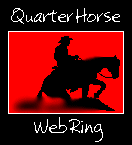

The American Quarter Horse is the first all-American breed. A distinctive type, it was bred in Virginia and the Seaboard Settlements very early in the seventeenth century. Its supporters claim that it is "the most popular horse in the world". To support that claim, there are more than 2 1/2 million entries in the American Quarter Horse Association's register.
The first significant import of English horses to Virginia was in 1611, well before the establishment of the Thoroughbred in England. Therefore, they would have had a background of native, eastern and Spanish blood.
Crossed with the stock of Spanish origin already in America, these horses became the foundation for the Quarter Horse, which quickly evolved into a compact horse with massively muscled quarters.
The settlers used them for farm work, herding cattle, hauling lumber, in light harness and under saddle. The sport-loving, English settlers also raced them on quarter-mile stretches - hence the name Quarter Horse. This also explains why the breed developed an explosive ability to spring over short distance.
In the West, the Quarter Horse made another name for itself as the perfect cow pony. Today, it excels as a trail mount, cutting horse, hunter and pleasure horse.
The Quarter Horse does not have or need the Thoroughbred's length of head. Instead, it is relatively short and wide, with a small muzzle and a shallow, firm mouth. The neck needs to be fairly long and flexible as the Quarter Horse works with its neck extended and its head down. An arched or crested neck would be undesirable. The head joins the neck at an angle of 45 degrees. There should not be too much thickness through the jowl, but the jawbones are wide apart at the top so as not to restrict the breathing. The excellent saddle back of this breed is due to the well-defined withers that extend back beyond the top of the shoulder to hold the saddle firmly in place. Heavy, muscular quarters of depth and width are characteristic of this chunky horse. The hind legs are heavily muscled through the thighs and gaskins down to the strong hock joint. The cannons are short with the hock set low to the ground. There is no play in the joint other than directly forward. The stifle is very deep. When viewed from behind, it extends out below the hip and above the gaskin and is the widest part of the horse. The underine, or belly, is longer than the back and must never cut high into the flank to disturb the compact symmetry of the outline. The usual color is chestnut but any solid color is acceptable. The Quarter Horse stnads between 15-16hh.
Reference: The Ultimate Horse Book; Elwyn Hartley Edwards; 1991
The National Quarter Horse Foundation Association
Quarter Horse World
American Quarter Horse Association
America's Quarter Horse
QuarterHorses.com
Background photo courtesy of Pleasure Horse Journal
Reference picture courtesy of The Ultimate Horse Site
 |
|
<
Prev
|
Random
|
Next
>
|
